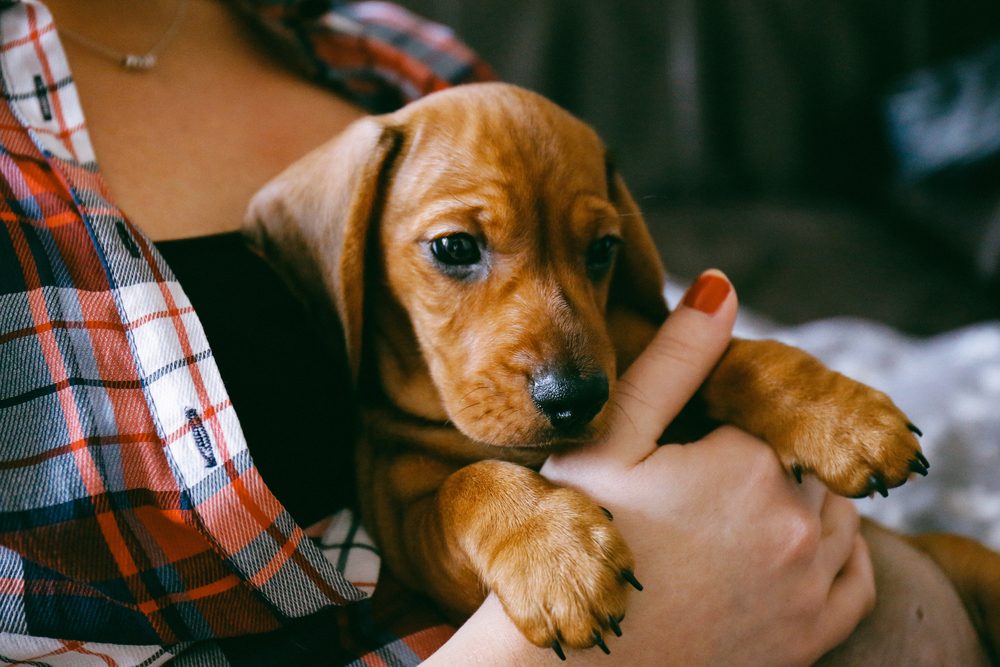Is a puppy in your near future? Here’s how to make his transition from rescue organization or breeder to your home as easy as possible.
Bringing a puppy home is a joyous time for the people in a family, and it should be for the puppy as well. Planning, play, training, and timing are all part of the equation that equals a happy home life for all of you.
If this is your first puppy, study up before he comes home. Read about training, think about what you will feed him, decide who his veterinarian will be, and decide where he will sleep. All of these decisions will come into play as you integrate your pup into the family. Here’s how a typical day might go as you begin your life together.
Home Base
Staying in a crate will keep both the puppy and your possessions safe when you are not able to watch him. You will not want your puppy finding things to ingest that will cause an emergency visit to the veterinarian or force you to replace an expensive piece of furniture or pair of shoes.
To make the crate a happy place, give the pup’s meals in it and sit right there as he eats. Then immediately take him out to relieve himself. You’re establishing a schedule and associating mealtime and potty time.
Training Practice
One of the easiest things to teach is sit. I do this by saying “Sit” while holding a ball over the puppy’s head. When he looks up at the ball, his body will naturally move into a sitting position. Now toss or roll the ball and say “Take it.” That will be his reward for sitting as well as the beginning of a fun game and a working vocabulary.
Once your new puppy has eaten, relieved himself, had a brief lesson, and started to learn a fun game, it will be time to go into his crate for a nap. Make sure he has something safe to chew on and keep an eye on how he’s doing for the first few times he’s in his crate.
Playtime and Puppy Friends
It’s great if your puppy can have playdates with other sweet puppies his age. I prefer small groups or one-on-one playdates to dog parks, which can be overwhelming to a young dog and not so safe, even after he’s had all his puppy shots. Speaking of shots, you might be told to keep him in until he’s had all his shots, but he needs to get out and see the world while he’s still young. A safe way to get him out and about is to carry him in your jacket or a sling next to your body.
Once it’s okay for him to walk alongside you, watch carefully to make sure he feels comfortable. It’s fine in the beginning to let him tell you when he needs a break and then to put him back in the nest your jacket offers. Because I live in a big, noisy city, I try to alternate quieter streets with noisier ones and walking with being carried. Reward your pup with small but special food treats periodically as he takes it all in. Treats can help to make any situation, from clattering trashcans to loud traffic sounds, as positive as possible, rather than a neutral or worse yet a negative experience.
Smart Start
I love playing brain games with my dogs. For a new pup, the kind of play that teaches but does not get him too revved up is ideal. Not only is it okay for your dog to play without getting wild, it’s preferable. If you can find ways to engage him that involve using his muscles and his brain, this is a big plus.
When puppies get too excited, they nip. Sometimes they nip just because they are puppies. Always have a toy handy to offer the pup. Better he chew on a ball or stuffed animal than on your fingers. If this distraction doesn’t work, he may just be overtired and need a nap in his crate.
When your puppy wakes from his nap, he’ll need a walk to relieve himself. Then it’s time for more playing and teaching. For a fun game, sit on the living room floor with your back against a piece of furniture and your legs straight out in front of you. Now toss a ball just a short distance so that the puppy has to jump over your legs to get it. As you toss, say “over,” and praise him when he makes the small jump. Next time, say “take it” or “fetch” when you toss the ball and “over” when he sails over your legs.
Once the pup understands this game, tent your legs by lifting your knees but keeping your feet on the floor. Roll the ball from where the puppy is so that it goes beneath your legs and to your other side, saying “take it” and then “under.”
Now you have started your puppy listening to the sound of words and understanding that the words you say to him have meaning. By making yourself an integral part of the games he plays, you are part of his fun and helping him to bond with you. By naming the activities and the objects in each game, you are helping your pup to grow up to be a smarter dog and a more attentive companion.
Getting a sweet new puppy is like all the holidays rolled into one. Joy and sweetness will replace the things you sometimes worry about with laughter and fun, and the time you spend playing with your puppy and teaching him words and manners might just be the best part of your day.
This article was reviewed/edited by board-certified veterinary behaviorist Dr. Kenneth Martin and/or veterinary technician specialist in behavior Debbie Martin, LVT.








